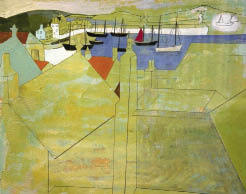Art fraudsters, especially forgers, have a popular appeal akin to Robin Hood. Their cock-a-snook cunning provides a twist on those money shots on the Antiques Roadshow when some dotty great aunt from Sidmouth discovers her umbrella stand is Ming Dynasty. ‘How much?’ cries Dotty. The forger levels the field from the other side of the pitch. When some shipping magnate finds his Monet ‘Nympheas’ is more pond scum than Giverny gold the public collapses into bouts of schadenfreude.
Many books and films have covered this subject, and yet The Conman has a particularly interesting tale to tell. This is a true story not only of dubious oils but also the obfuscation of the paper trail which allows a work of art to be declared genuine. Laney Salisbury and Aly Sujo have expertly researched the story of Profesor John Drewe, supposedly a London-based scientist, who in the late 1980s answered a small ad in Private Eye. John Myatt, a struggling artist and lone parent of two young children, offered ‘genuine fakes’, copies of famous 19th- and 20th-century works or pastiches painted to the whim of a client, mostly with some dubious, tacky attempt at humour or racy artistic licence.
Drew saw Myatt’s enterprise for what it was — a desperate throw of the dice by a talented man down on his luck — and mercilessly took advantage. He commissioned a stream of works, providing Myatt with financial support and an escape from provincial domesticity. ‘It was like going to the pictures,’ Myatt late recalled. ‘He just took me out of my world.’
Drewe then dropped him, as he began passing off the canvasses as the real thing. This was greased with bogus provenances acquired by chumming up to the archivists at the Tate, ICA and V&A and doctoring exhibition and purchase records. It was perfect timing: archives were rudimentary and ill-secured, and the art market was booming. A decade’s run of luck saw him palm off over 200 counterfeit Giacomettis, Sutherlands and Nicholsons, among many other modern masters’ work, through the capital’s dealers and auction houses.
Salisbury and Sujo have written a fascinating and entertaining book. It examines the idiosyncratic bylaws of the art world with glee, while injecting the narrative with the pace and patter of Dashiell Hammett or Raymond Chandler. Chapter headings read like pulp noir: ‘A Slow Burn’, ‘A Loaded Briefcase’ and, my favourite, ‘The Macaroni Caper’.
Myatt remains the victim of the piece, permanently in Drewe’s shadow. The mastermind himself — fantasist and huckster, who claimed variously to be a historian of the Nazi era, an MOD consultant, an army lieutenant and an adroit hang-glider — occupies centre stage throughout.






Comments